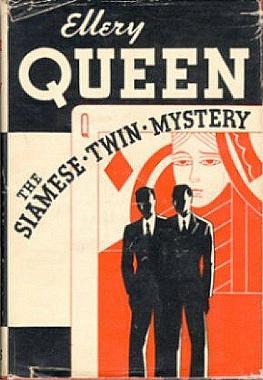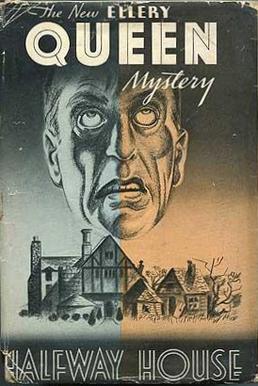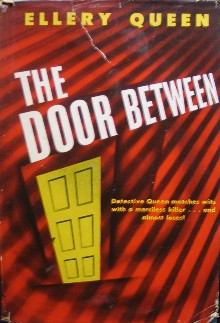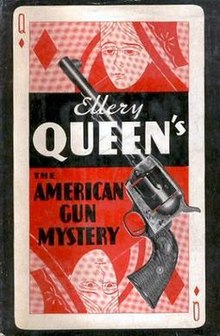Plot summary
Buck Horne and his faithful horse Injun were once the heroes of many a Western movie in the early days of Hollywood, but when tastes changed, Buck found his talents no longer required. Down on his luck, he went to work in a rodeo exhibition that was appearing in a New York coliseum, giving exhibitions of roping, fancy shooting, and the riding tricks that made him famous. With twenty thousand people in the stands, a group of celebrities including detective Ellery Queen in the boxes, and a full cohort of newsreel movie photographers recording the event for posterity, Buck and forty-one cowboys and cowgirls gallop around the track, whooping and firing their six-guns — until the former movie star is shot in the heart and trampled under the galloping hooves.
Suspicion falls on many of the rodeo's performers and staff, and even on some of the celebrities, but one crucial and baffling point must be explained before anyone can be arrested. Even though all 20,000-odd people and the entire arena are searched, and the entire event can be reviewed on film, the specific murder gun cannot be found. Ellery Queen works his way through the details of the murderer's clever plot to set a trap and reveal two astounding surprises — the identity of the murderer and the hiding place of the gun.
Literary significance & criticism
(See Ellery Queen.) The character of Ellery Queen and the more-or-less locked room mystery were probably suggested by the novels featuring detective Philo Vance by S.S. Van Dine, which were very popular at the time. At this point in time, however, Van Dine's sales were dropping and Queen's were beginning to rise. This novel was the sixth in a long series of novels featuring Ellery Queen, the first nine containing a nationality in the title.
The introduction to this novel contained a detail which is now not considered part of the Ellery Queen canon. The introduction is written as by the anonymous "J.J. McC.", a friend of the Queens. Other details of the lives of the fictional Queen family contained in earlier introductions later disappear and are never mentioned again; the introductory device of "J.J. McC." ends with the tenth Queen novel, Halfway House. However, "J.J." actually appears in several chapters here, discussing this case with Ellery (and makes a second and last appearance in 1967's Face to Face).
The novel, and the other "nationality" mysteries, had the unusual feature of a "Challenge to the Reader" just before the ending is revealed—the novel breaks the fourth wall and speaks directly to the reader, stating that all essential facts have been revealed and the unique solution to the mystery is now possible.
This novel was published in a Mercury edition in 1951 titled Death at the Rodeo.

A whodunit or whodunnit is a complex plot-driven variety of detective fiction in which the puzzle regarding who committed the crime is the main focus. The reader or viewer is provided with the clues to the case, from which the identity of the perpetrator may be deduced before the story provides the revelation itself at its climax. The investigation is usually conducted by an eccentric, amateur, or semi-professional detective.

Ellery Queen is a pseudonym created in 1928 by the American detective fiction writers Frederic Dannay (1905–1982) and Manfred Bennington Lee (1905–1971). It is also the name of their main fictional detective, a mystery writer in New York City who helps his police inspector father solve baffling murder mysteries. Dannay and Lee wrote most of the novels and short story collections in which Ellery Queen appears as a character, and these books were among the most popular American mysteries published between 1929 and 1971. Under the pseudonym Ellery Queen, they also edited more than thirty anthologies of crime fiction and true crime. Dannay founded, and for many years edited, the crime fiction magazine Ellery Queen's Mystery Magazine, which has been published continuously from 1941 to the present. From 1961 onwards, Dannay and Lee commissioned other authors to write thrillers using the pseudonym Ellery Queen, but not featuring Ellery Queen as a character; some such novels were juvenile and were credited to Ellery Queen Jr. They also wrote four mysteries under the pseudonym Barnaby Ross, which featured the detective Drury Lane. Several movies, radio shows, and television shows were based on their works.

The "locked-room" or "impossible crime" mystery is a type of crime seen in crime and detective fiction. The crime in question, typically murder, is committed in circumstances under which it appeared impossible for the perpetrator to enter the crime scene, commit the crime, and leave undetected. The crime in question typically involves a situation whereby an intruder could not have left; for example the original literal "locked room": a murder victim found in a windowless room locked from the inside at the time of discovery. Following other conventions of classic detective fiction, the reader is normally presented with the puzzle and all of the clues, and is encouraged to solve the mystery before the solution is revealed in a dramatic climax.

Mystery is a fiction genre where the nature of an event, usually a murder or other crime, remains mysterious until the end of the story. Often within a closed circle of suspects, each suspect is usually provided with a credible motive and a reasonable opportunity for committing the crime. The central character is often a detective, who eventually solves the mystery by logical deduction from facts presented to the reader. Some mystery books are non-fiction. Mystery fiction can be detective stories in which the emphasis is on the puzzle or suspense element and its logical solution such as a whodunit. Mystery fiction can be contrasted with hardboiled detective stories, which focus on action and gritty realism.
Clayton Rawson was an American mystery writer, editor, and amateur magician. His four novels frequently invoke his great knowledge of stage magic and feature as their fictional detective The Great Merlini, a professional magician who runs a shop selling magic supplies. He also wrote four short stories in 1940 about a stage magician named Don Diavolo, who appears as a minor character in one of the novels featuring The Great Merlini. "Don Diavolo is a magician who perfects his tricks in a Greenwich Village basement where he is frequently visited by the harried Inspector Church of Homicide, either to arrest the Don for an impossible crime or to ask him to solve it."

Philo Vance is a fictional amateur detective originally featured in 12 crime novels by S. S. Van Dine in the 1920s and 1930s. During that time, Vance was immensely popular in books, films, and radio. He was portrayed as a stylish—even foppish—dandy, a New York bon vivant possessing a highly intellectual bent. "S. S. Van Dine" was the pen name of Willard Huntington Wright, a prominent art critic who initially sought to conceal his authorship of the novels. Van Dine was also a fictional character in the books, a sort of Dr. Watson figure who accompanied Vance and chronicled his exploits.

The Golden Age of Detective Fiction was an era of classic murder mystery novels of similar patterns and styles, predominantly in the 1920s and 1930s.
Richard Leighton Levinson was an American screenwriter and producer who often worked in collaboration with William Link.

The Roman Hat Mystery is a novel that was written in 1929 by Ellery Queen. It is the first of the Ellery Queen mysteries.

The French Powder Mystery is a novel that was written in 1930 by Ellery Queen. It is the second of the Ellery Queen mysteries.

The Dutch Shoe Mystery is a novel which was written in 1931 by Ellery Queen. It is the third of the Ellery Queen mysteries.

The Greek Coffin Mystery is a 1932 novel by Ellery Queen. It is the fourth of the Ellery Queen mysteries.

The Egyptian Cross Mystery is a novel that was written in 1932 by Ellery Queen. It is the fifth of the Ellery Queen mysteries.

The Siamese Twin Mystery is an English language American novel written in 1933 by Ellery Queen. It is the seventh of the Ellery Queen mysteries.

The Chinese Orange Mystery is a novel that was written in 1934 by Ellery Queen. It is the eighth of the Ellery Queen mysteries.

The Spanish Cape Mystery is a novel that was written by Ellery Queen as the ninth book of the Ellery Queen mysteries. Published in April in hardcover by Frederick A. Stokes, it also appeared as a "complete, book-length novel" in the April 1935 issue of Redbook.

The Lamp of God is a novella by Ellery Queen that was originally published in the Detective Story Magazine in 1935. Later, it was collected in the short story collection The New Adventures of Ellery Queen in 1940. Finally, it was published as a standalone book by Dell Books in 1950.

Halfway House is a novel that was written in 1936 by Ellery Queen. It is a mystery novel primarily set in New Jersey, United States.

The Door Between is a novel that was published in 1937 by Ellery Queen. It is a mystery novel primarily set in New York City, United States.

Ten Days' Wonder is a novel that was published in 1948 by Ellery Queen. It is a mystery novel primarily set in the imaginary town of Wrightsville, United States.















